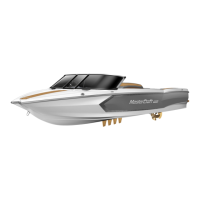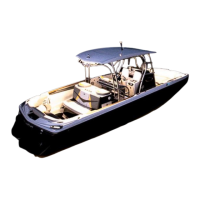MASTERCRAFT TRAILERS
26-8
Trailer Jack
MasterCraft recommends using the jack to lift the coupling of a loaded trailer from the hitch ball and for
moving the trailer about when it is disconnected from the towing vehicle. The trailer jack should be lowered to a
minimum position and tilted horizontally before moving the trailer.
Like any mechanical assembly, a jack requires maintenance to function properly over a long period of time. The
drive gear and the rack-and-pinion should be greased. The caster and wheel bearing should be oiled frequently.
Tie-Downs
Ensuring that your Mas-terCraft is held securely in place on the trailer’s hull support, especially when
underway, is extremely important. If it is not firmly and properly secured, your boat can be damaged as it
bounces against the hull supports.
MasterCraft’s Boat Buddy System is located on the winch stand. Ask your MasterCraft dealer to demonstrate
the proper use of the Boat Buddy System. A separate winch strap is provided and should then be attached to
hold the boat down on the trailer. Besides keeping your boat from sliding off the rear if the Boat Buddy latch
would fail, it will keep the boat on the trailer during quick stops or minor collisions.
As noted previously, it is very important to be sure that the transom of your MasterCraft boat is resting
fully and securely on the supports provided at the rear end of the trailer, and that it remains in place when
parked or underway.
Tie-downs have been added on both bow and transom of the boat.
Hitching Up
• Hitch only to the ball size marked on the coupling.
• Be certain the ball clamp captures the ball and lever or the handwell is fully closed or tightened. Insert safety
pin or optional lock pin.
• Cross the safety cables under the coupling.
• Allow only enough slack in the safety cables
to handle turns. When hitching your trailer,
you should always observe each item of the
“Trailer Check List.” Hitching your trailer to
your tow vehicle can be a one-person job,
but it is easier if you have a second person to
help you.
Here are the basic steps:
• Back your tow vehicle as close as possible to
the trailer. It’s easier–and safer– than pulling
the trailer to your car or truck.
• Check to be sure the coupler-locking device is
released.
• Raise the front end of the trailer with your
jack, position the coupler directly over the hitch
ball and lower until it is all the way down over
the ball.
• Check under the coupling to be certain that
the ball clamp is below the ball and not riding
on top of the ball.
• Lock the coupler to the hitch ball. To be sure
it is in the locked position and securely in place,
raise up on the trailer tongue. If it comes loose
made and any damages or worn parts replaced.
Wet brakes usually do not hold especially well. If your wheels have been in water, several brake applications
at slow speeds should dry them out.

